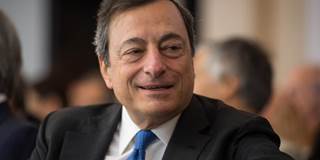It has now been nearly half a year since the European Central Bank declared its intention to buy some €1.1 trillion worth of eurozone government bonds. Contrary to the claims of the policy’s supporters, there is little evidence so far that the policy is working.
BRUSSELS – It has now been nearly half a year since the European Central Bank declared its intention to buy some €1.1 trillion ($1.3 trillion) worth of eurozone bonds. When it first announced the so-called “extended asset-purchase program” in January, the ECB emphasized that it was only expanding an existing program, under which it had been buying modest quantities of private-sector bonds, to cover government paper. But this pretense of continuity was just that: a pretense.
In reality, by purchasing large volumes of government bonds, the ECB was crossing the Rubicon; after all, it is explicitly prohibited from financing governments. The ECB’s defense was that that the program was the only way to move inflation closer to its target of approximately 2%. Moreover, it pointed out, it was merely following the example of other major central banks, including the Bank of England, the Bank of Japan, and especially the US Federal Reserve, whose program of quantitative easing (QE) entailed the purchase of more than $2 trillion worth of long-term securities from 2008 to 2012.
Legal uncertainty aside, whether the ECB’s decision to pursue QE can be justified ultimately depends on its impact. But, after six months, that impact remains difficult to assess.

BRUSSELS – It has now been nearly half a year since the European Central Bank declared its intention to buy some €1.1 trillion ($1.3 trillion) worth of eurozone bonds. When it first announced the so-called “extended asset-purchase program” in January, the ECB emphasized that it was only expanding an existing program, under which it had been buying modest quantities of private-sector bonds, to cover government paper. But this pretense of continuity was just that: a pretense.
In reality, by purchasing large volumes of government bonds, the ECB was crossing the Rubicon; after all, it is explicitly prohibited from financing governments. The ECB’s defense was that that the program was the only way to move inflation closer to its target of approximately 2%. Moreover, it pointed out, it was merely following the example of other major central banks, including the Bank of England, the Bank of Japan, and especially the US Federal Reserve, whose program of quantitative easing (QE) entailed the purchase of more than $2 trillion worth of long-term securities from 2008 to 2012.
Legal uncertainty aside, whether the ECB’s decision to pursue QE can be justified ultimately depends on its impact. But, after six months, that impact remains difficult to assess.